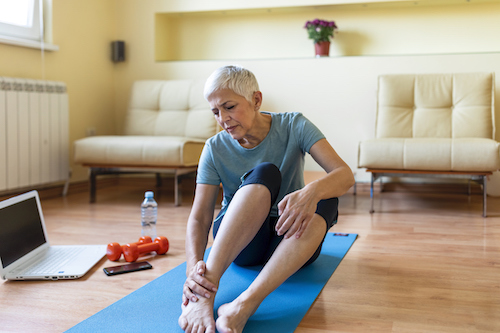Authored by Dr. Pier Boutin, MD
Every day in my orthopedic practice I coach patients about the power they hold against the formidable force of arthritis. Too often, I see patients with enlarged and painful knees who can no longer get up from a chair without help. Their knee joints no longer bend far enough to tuck their legs and feet under the chair. Once stiffness takes hold, it’s hard to reverse.

I remind these patients that while they may not be able to undo the damage, they usually can control the effect on the joint and their life.
We often respond to pain by avoiding any movement or activity that causes discomfort.But in the case of arthritis, we need to overcome this instinct. Here’s where to start.
What is causing your arthritis pain?
In order to overcome your pain, it’s essential to remember exactly what caused it in the first place. Arthritis is the deterioration of the cartilage in the joints. Cartilage is the soft end cap at the end of a bone. This resistant fibrous covering allows for smooth joint motion. Inflammation or trauma initiates the erosion of this protective layer, leaving the bone uncovered.
Bone is sharp and unforgiving when it rubs on another bone, bone-on-bone. So loss of cartilage leads to swelling, pain and stiffness of the joints.

Why you should keep moving
I encourage my patients diagnosed with arthritis of the knee to keep moving their joints despite the pain.
The results are clear when they do. Patients who stay active despite arthritic joints often delay or eliminate the need for joint replacement surgery. That’s because muscles around the joints weaken with disuse. These muscles are key to protecting the joint. Stronger muscles cushion and lessen the strain across the joints.
The key is to find ways to modify workouts and maintain joint motion. True, there will be some pain. By switching from walking exercises to the recumbent bicycle or swimming will decrease the strain across the weight bearing joint while working the muscles and keeping joints flexible.
Avoiding pain and exercise will NOT stop the progression of arthritis. Better to have a painful knee that moves than a painful knee that no longer moves.
Maintaining joint mobility also improves the outcome of total knee replacement when and if that becomes inevitable. There is a direct correlation between pre-surgery to post-surgery range of motion. If your knee only bends to 80 degrees before surgery,you will struggle to reach 90 degrees after surgery. In order to get up easily from a chair, you need 120 degrees. So staying active isn’t just important, it’s essential.
What doesn’t have to happen
I wish I had known about the importance of continued movement 30 years ago in the early days of my practice. When one of my patients developed arthritis of the hands,the therapist made her a splint to keep the finger immobilized when she felt pain.
I watched the incremental progression of the disease and its effect on her life.The enlarged knuckles of her hands were no longer painful but they were stiff. She could no longer hold a paintbrush. The golf club twisted out of her weak grip. Today she must even rely on others for help with simple daily chores such as pouring a glass of water.
If she had exercised and bent the fingers despite the pain during the destruction phase, the joints would still be enlarged — but she could have maintained her independence and continued the activities that gave her most pleasure.
The lesson is to move and keep joint mobility despite some pain!
 |
What’s causing your joint pain? Find out if you should be worried about your symptoms. |










